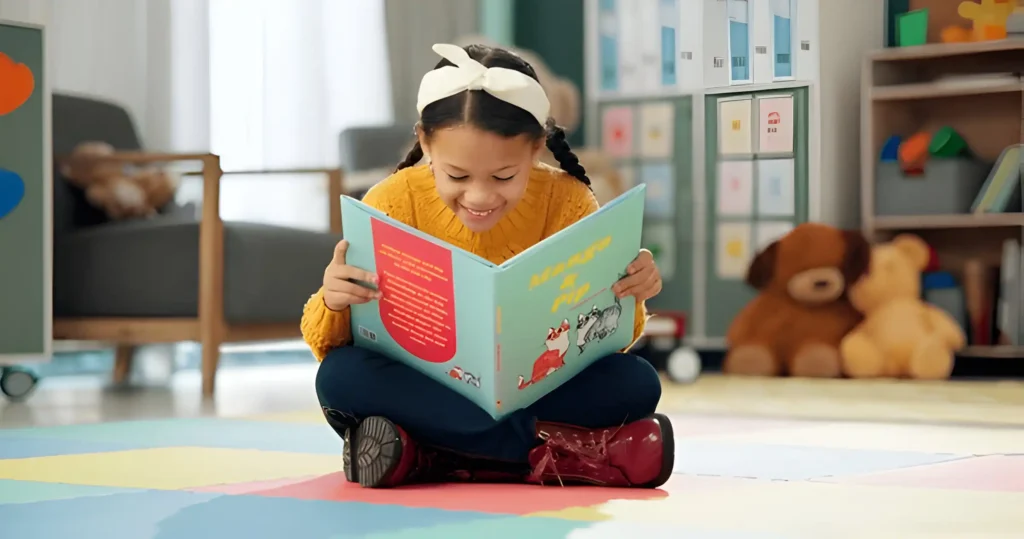Reading plays an invaluable role in a child’s development, shaping their thinking, language skills, emotional intelligence, and overall worldview. But what if you could significantly nurture your child’s mind with as little as 15 minutes of reading daily? A well-structured, consistent reading routine provides not only a rich foundation for academic success but also fosters emotional growth, creativity, and a lifelong love for learning. Let’s explore how this small commitment can lead to substantial benefits in growing your child’s mind.

The Power of Daily Reading for Kids
The idea that reading can shape a child’s mind is nothing new, yet the impact of just 15 minutes daily often goes unnoticed. While the busyness of everyday life might make it difficult to prioritize, carving out time for daily reading doesn’t require an extensive overhaul of your schedule. This small but powerful habit can significantly boost cognitive development, even in the busiest households.
Daily reading, especially in the formative years, helps establish neurological pathways that support critical thinking, language acquisition, and emotional resilience. It opens a world of possibilities for your child, sparking curiosity and a deeper understanding of the world. Engaging with stories develops both left-brain logic and right-brain creativity, and it doesn’t take long for these benefits to show.
Why Daily Reading is Key to Development
Children’s brains are highly receptive to stimuli, and reading provides rich material that stimulates mental growth. In fact, studies have shown that daily reading correlates with higher academic performance, especially in areas like vocabulary, comprehension, and analytical skills. More importantly, this habit instills a sense of wonder and a love for learning that will extend far beyond the school years.
Reading also builds emotional intelligence. By encountering different perspectives and experiences through stories, children learn empathy and develop the ability to understand others’ emotions. In addition, listening to and engaging with stories can serve as a platform for children to process their own feelings in a safe, imaginative space.
Benefits of Reading to Children
From birth, children begin absorbing language and understanding the rhythms of communication. When you read aloud to them, you help shape the way they interpret and respond to language. Reading to your child fosters vocabulary development, better speech patterns, and even stronger listening skills.
There’s also a physical closeness to reading aloud that helps deepen the bond between parents and children. Those 15 minutes of reading each day provide a chance to pause, connect, and engage in something meaningful together. That emotional connection plays a crucial role in both their sense of security and their emotional development.
How Reading Shapes Cognitive and Emotional Growth
Regular reading sessions offer children a controlled way to experience complex emotions and problem-solving scenarios. The brain works overtime during storytime, identifying patterns, building connections, and even rehearsing how to approach real-life challenges. Kids absorb a wide array of emotions, often learning how to articulate their feelings better.
Children who read regularly develop stronger problem-solving abilities because stories often involve challenges that need to be overcome. Whether it’s a character finding their way out of a difficult situation or discovering the consequences of their actions, children pick up on subtle cues that help build their own cognitive flexibility.
Enhancing Vocabulary Through Reading
One of the most immediate benefits of reading daily is vocabulary acquisition. Words children might never encounter in day-to-day conversations appear frequently in books, expanding their language horizons. This vocabulary boost becomes even more crucial as children transition from early literacy to more complex academic learning.
With every new book, children learn how to structure sentences, recognize word meanings in context, and understand nuances in language. This not only prepares them for academic success but also strengthens their communication skills in a broader sense.
The Role of Reading in Social Skills
Books introduce children to diverse characters and cultures, helping them to develop empathy and social understanding. When children encounter different perspectives through stories, they begin to grasp the concept of other people’s feelings and experiences. This early development of empathy and understanding plays a vital role in their social interactions as they grow.
Moreover, many stories revolve around characters navigating friendships, conflicts, or challenges, which provides young readers with examples of problem-solving in social contexts. Reading books together and discussing these scenarios can prompt meaningful conversations between parent and child about social behavior, choices, and ethics.
Boosting Creativity with Daily Reading
Reading opens the door to imaginative worlds and endless possibilities. As children hear or read stories, they exercise their creativity by visualizing characters, settings, and events. This daily practice of engaging with new ideas nurtures a child’s imagination and can inspire creative thinking in other areas of their lives, from art to problem-solving.
In many ways, reading teaches children to think outside the box. Through exposure to different worlds and ideas, they learn that there are multiple ways to approach a situation, sparking innovative thought processes that can extend beyond the pages of the book.
Developing a Lifelong Love for Learning
Instilling a daily reading habit at a young age nurtures curiosity and an intrinsic love for learning. Kids who associate reading with joy and discovery often carry these attitudes into their academic lives and future career paths. Starting with just 15 minutes a day creates a sense of achievement without overwhelming them, gradually building their endurance for longer reading sessions as they grow older.
How to Start a 15-Minute Reading Routine
Starting a daily reading routine is easier than you might think. It doesn’t require elaborate planning, but it does benefit from consistency. First, set aside a specific time each day for reading, whether it’s before bed, after school, or during breakfast. Making it part of your routine helps ensure it becomes a regular part of your child’s day.
Finding age-appropriate and engaging books is another key component. Choose stories that match your child’s interests, and don’t be afraid to let them participate in selecting books. This encourages ownership over the reading process and makes it more enjoyable for them.
Finding Age-Appropriate Books
Choosing the right books is essential to maintaining your child’s interest and ensuring their reading experience is both fun and educational. Age-appropriate books are designed to meet the cognitive and emotional development levels of children at different stages. For younger children, picture books with engaging visuals and simple language can help hold their attention while introducing them to the basics of storytelling. As they grow older, chapter books with more complex plots and characters can challenge their comprehension skills and keep them engaged.
A great way to select books is by considering your child’s interests. If your child loves dinosaurs, for instance, finding books about prehistoric adventures can excite them and make the daily reading session feel more like playtime than a task. Incorporating a mix of fiction and non-fiction books is also beneficial, as it exposes them to a variety of genres and information.
Reading Aloud vs. Independent Reading
The transition from reading aloud to independent reading is a milestone in every child’s educational journey. Reading aloud to younger children offers them the opportunity to hear how language sounds, while they follow along visually, gradually building their own reading skills. It’s also a time to bond, making reading an enjoyable shared experience. Once a child shows readiness—typically around age 6 to 7—they can begin practicing independent reading with easier texts.
Balancing both reading aloud and independent reading is ideal. While independent reading helps a child gain confidence and autonomy, reading aloud provides access to stories that might be above their current reading level, exposing them to richer vocabulary and more complex ideas. Encourage a mix of both for a well-rounded reading routine.
Encouraging Reading as a Fun Activity
One of the most effective ways to ensure your child continues reading is by making the experience fun. A great way to do this is to incorporate reading games or challenges. You can use simple incentives like creating a reading chart where your child earns stickers or stars for each book they complete, with a small reward at the end. Another idea is to act out parts of the story together, or even create alternative endings to the tales you read.
Incorporating themed reading sessions, such as “pirate week” or “fairy tale Fridays,” can also add excitement and give children something to look forward to. By presenting reading as an adventure rather than a chore, you nurture a positive relationship with books that will last a lifetime.
Creating a Comfortable Reading Environment
Setting up a dedicated, cozy reading space can significantly enhance your child’s experience. This could be a reading nook in the corner of their room, complete with soft cushions, a small bookshelf, and adequate lighting. Having a space that is specifically for reading helps create a routine and signals to your child that it’s time to relax and focus.
Comfort and tranquility are essential for maintaining concentration during those 15 minutes. Keep distractions like toys, electronics, and loud noises to a minimum. A peaceful atmosphere will allow your child to become immersed in the story, deepening their engagement and enjoyment.
Setting Realistic Goals for Reading
Establishing achievable goals is critical when starting a 15-minute daily reading routine. Rather than setting high expectations, aim for small, consistent steps. For younger children, completing a few pages or chapters during each session might be an appropriate goal. As your child’s reading abilities progress, you can gradually increase the complexity of the books or the length of time they spend reading.
Celebrate the small victories along the way—whether it’s completing their first chapter book or learning a new word—and acknowledge their progress. These positive reinforcements will encourage them to keep going and will build their confidence as readers.
Best Practices for Daily Reading
To get the most out of your 15-minute reading sessions, it’s important to use strategies that keep your child engaged and interested. Here are a few best practices:
- Read with enthusiasm: When reading aloud, use different voices for characters and change your tone to reflect the mood of the story. This keeps your child’s attention and makes the story more vivid in their imagination.
- Ask questions: Pause at key moments in the story to ask your child what they think will happen next, or how they feel about the characters. This encourages critical thinking and helps them engage with the story on a deeper level.
- Encourage interaction: Let your child take part in turning the pages, pointing out pictures, or even reading a few words or sentences themselves. Active participation enhances their involvement and builds their confidence in handling books.
- Consistency is key: Make sure you stick to the daily habit, even on busy days. Whether it’s in the morning, after school, or at bedtime, ensure you fit those 15 minutes in each day. The consistency will help solidify reading as a natural and enjoyable part of your child’s routine.
Asking Open-Ended Questions During Reading
Open-ended questions can turn a simple reading session into an insightful conversation, deepening your child’s understanding of the text and promoting critical thinking. Instead of asking yes-or-no questions like “Did you like the book?” try questions like:
- “Why do you think the character did that?”
- “What would you have done differently?”
- “How do you think the story will end?”
These questions encourage your child to think critically and articulate their thoughts, building both language skills and problem-solving abilities. It also makes the reading experience more interactive, fostering a sense of participation in the storytelling process.
Reading with Expression and Emotion
Reading with expression helps bring stories to life. By using varied tones and voices, children can better understand the emotions of the characters and the tension in the plot. When you model this during read-aloud sessions, it teaches your child to do the same, enhancing their comprehension and enjoyment of the story.
For example, if a character is whispering or excited, lower or raise your voice accordingly. This method keeps children engaged and helps them pick up on the subtleties of the narrative, which can also improve their listening and language skills.
Involving Kids in the Storytelling Process
One great way to encourage active engagement with books is by involving your child in retelling the story or predicting what will happen next. After finishing a book, ask your child to describe the key events in their own words. This reinforces comprehension and memory, and it’s also a fun way to see how they interpret the story.
Allowing children to “be the author” by coming up with alternative endings or new adventures for the characters stimulates their imagination and creativity. It transforms reading from a passive activity into an interactive, imaginative process.
Overcoming Common Challenges
Even with the best-laid plans, some children may struggle with the habit of daily reading. Here are some common challenges and ways to overcome them:
Handling Short Attention Spans
Children, especially younger ones, might struggle to sit still for 15 minutes straight. In these cases, it’s perfectly fine to break the reading time into two shorter sessions—one in the morning and one in the evening, for example. You can also make the reading time more interactive by incorporating questions, acting out parts of the story, or asking your child to illustrate a scene afterward. Gradually, their attention span will increase.
What to Do When Your Child Resists Reading
If your child is resistant to reading, start with something they love. Whether it’s a book about their favorite TV character or a comic book, the content is less important than getting them into the habit. Gradually introduce more varied books as their interest grows. Positive reinforcement and patience are key. If they see you enjoying books, they’ll be more inclined to try it themselves.
Incorporating Reading into Busy Schedules
For many families, busy schedules make it challenging to fit in daily reading. However, there are creative ways to ensure you get that 15 minutes of reading in. Consider these strategies:
- Multitasking with Audio Books: On days when sitting down to read isn’t feasible, try listening to an audiobook while driving to school or running errands. This helps keep the habit alive, even on the busiest of days.
- Reading on the Go: Bring books with you wherever you go—doctor’s offices, grocery store lines, or even during breakfast. Quick bursts of reading in between activities can still make a big difference.
Weekend Reading Adventures
Weekends provide the perfect opportunity to turn daily reading into an adventure. Plan themed reading days where the whole family reads books around a central theme—whether it’s pirates, space, or animals. You can even pair reading with related activities, like dressing up as the characters or visiting a local zoo after reading about wildlife. These activities make reading sessions more engaging and memorable for your child.
Tracking Progress and Celebrating Milestones
Tracking your child’s progress not only motivates them but also provides a clear picture of how far they’ve come. Use reading journals where your child can note down the books they’ve read and what they enjoyed about them. This reflection helps deepen their understanding of the material and gives them a sense of accomplishment.
Celebrating reading milestones, such as finishing a set number of books, can be a fun way to encourage continued reading. Offer small rewards or plan special outings to celebrate their achievements.
Encouraging Sibling Reading Time
If you have more than one child, encourage sibling reading sessions where the older sibling reads to the younger one. This helps develop leadership skills in the older child while fostering a love for books in the younger sibling. Sibling reading time can also serve as a bonding experience and an opportunity for both children to practice their reading and listening skills.
FAQs
How early should I start reading to my child?
Reading can begin as early as infancy. Even newborns benefit from hearing the rhythm and sound of your voice. The earlier you start, the more naturally reading becomes a part of their routine.
How do I know if a book is too difficult for my child?
A good rule of thumb is to use the “Five Finger Rule.” Have your child read a page aloud, and if
they struggle with more than five words on the page, the book may be too challenging. It’s best to choose books where they can comfortably understand the majority of the content, with a few new words to keep them learning.
What if my child doesn’t enjoy reading?
Start by choosing topics or types of books they enjoy, like comics, graphic novels, or even magazines. Making reading fun and avoiding pressure can help. Over time, their interests will likely broaden.
How can I balance reading aloud with independent reading?
Incorporate both into your routine. Read aloud during family time, and encourage independent reading by setting aside a quiet time where your child can explore books on their own. Gradually, as their skills improve, they will rely more on independent reading.
How do audiobooks fit into a reading routine?
Audiobooks are a great way to supplement reading, especially on busy days. While not a replacement for reading print, audiobooks can help children develop listening skills and learn to follow narratives in a different format.
What if my child prefers digital books or e-readers?
Digital books and e-readers can be a good option, especially if your child finds them more engaging. Just be sure to balance screen time with physical books to foster a well-rounded reading habit.
Conclusion
Reading for just 15 minutes daily can have an incredible impact on your child’s intellectual, emotional, and creative development. By establishing a routine, choosing the right books, and making the process enjoyable, you can cultivate a lifelong love of reading that nurtures your child’s mind. Small, consistent efforts—whether through traditional books, audiobooks, or creative reading sessions—can spark growth and curiosity that will last a lifetime.






Trackbacks/Pingbacks